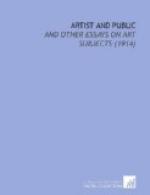We may also leave out of our present consideration Raphael’s achievement in the suggestion of space. It is a very real quality and a high one. It has doubtless always been an important element in the enjoyability of Raphael’s art, as it is almost the only enjoyable element, for many of us, in the art of Perugino. But it is an element that has only very recently been clearly perceived to exist. If it was enjoyed by the artists and critics, from Raphael’s day almost to our own, they were unconscious of the fact, and the probability is that we enjoy it more than they did. It will not account for the estimation in which they held Raphael, and still less will it account for the relative lack of interest in him to-day.
In truth the reason why many modern critics and painters almost dislike Raphael is the very reason for which he was so greatly revered. Coming in the nick of time, at the close of an epoch of investigation, himself a man of wide culture and quick intellect but of no special originality or emotional power, he learned from all his predecessors what they had to teach and, choosing from the elements of their art those which were suited to his purpose, formed a perfectly balanced and noble style which was immediately accepted as the only style suitable to the expression of lofty ideas in monumental form. He became the lawgiver, the founder of classicism, the formulator of the academic ideal. Not to admire him was to confess oneself a barbarian, and even those who did not really care for his art hardly dared to say so. As long as the academic ideal retained any validity his supremacy endured, and it was only with the definitive turning of modern art into the paths of romanticism and naturalism that revolt became possible.
But when the world became tired of Raphaelism it inevitably became unjust to Raphael. It forgot that it was not he who had made his art the test of that of others—who had erected what, with him, was a spontaneous and original creation into a rigid system of laws. It confounded him with his followers and imitators, and, being bored by them, began to find the master himself a bore.
For, eclectic as he was by nature, and founder as he was of the academic regime, the “grand style” of Raphael was yet a new and personal contribution to art. He drew from many sources, but the principle of combination was his own. His originality was in that mastery of composition which no one has ever denied him, but which is very differently rated as a quality of art by different temperaments. Almost everything specifically Raphaelesque in his work is the offspring of that power of design in which he is still the unapproached master. Modern criticism is right in denying that he was a draughtsman, if by draughtsman is meant one deeply preoccupied with form and structure for its own sake. His distinction was to invest the human figure with such forms as should best fit it to play its part in a scheme of




